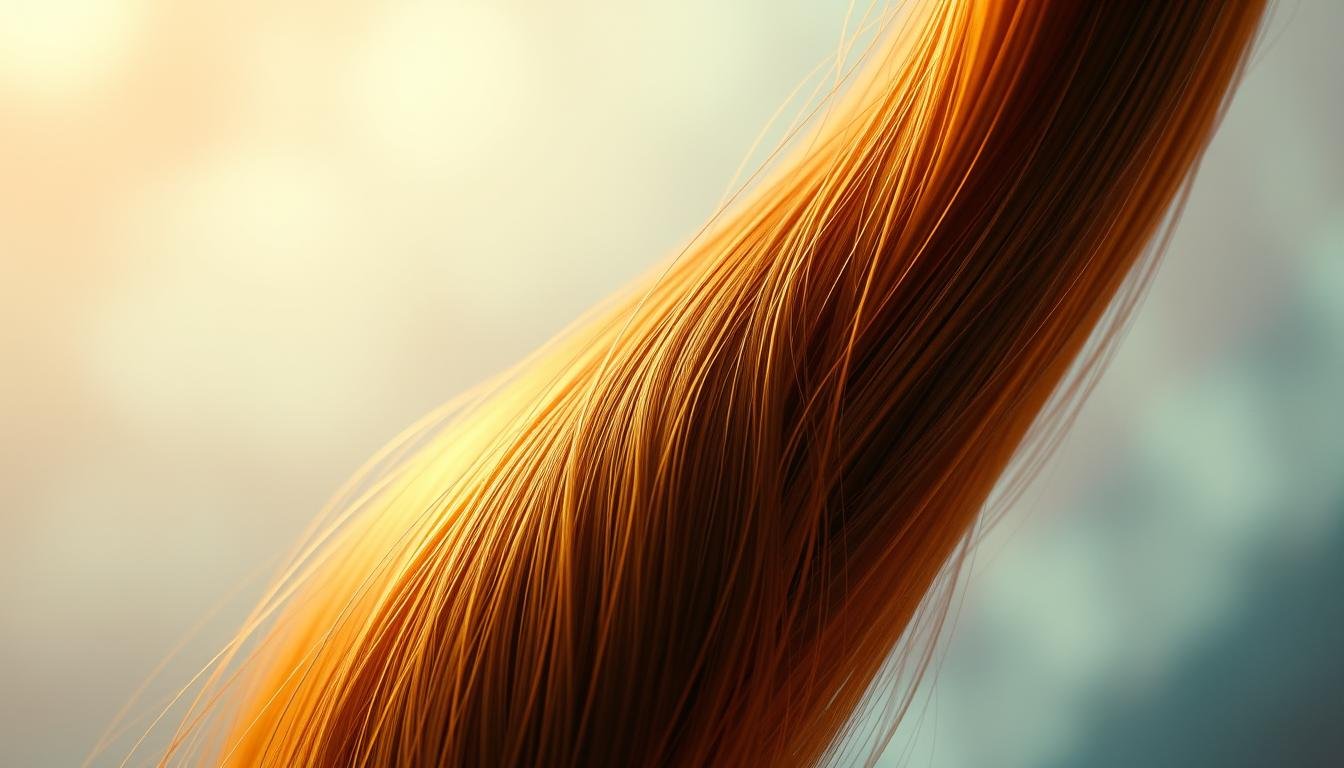Does Cutting Hair Make It Grow Faster? – Hair Growth Facts
Contrary to popular belief, cutting your hair does not actually make it grow faster. In fact, according to experts, hair growth originates from the scalp, not the ends. However, regular trims can contribute to the appearance of thicker, healthier-looking hair by preventing split ends from traveling up the hair shaft.
The average person’s hair grows about 1/2 inch per month, or 6 inches per year, regardless of how often they cut it. While a fresh trim may create the illusion of faster growth, the reality is that cutting hair does not directly impact the underlying biological processes that drive hair growth.
Key Takeaways
- Cutting hair does not make it grow faster, as hair growth originates from the scalp.
- Regular trims can contribute to healthier-looking hair by preventing split ends.
- The average person’s hair grows about 1/2 inch per month or 6 inches per year.
- A fresh trim may create the illusion of faster growth, but it doesn’t directly impact the biological processes behind hair growth.
- Proper hair care, such as using high-quality products and avoiding heat Damage, can help promote healthy hair growth.
Understanding Hair Growth Basics
Hair growth is a complex biological process that involves several distinct phases. The average person’s hair grows approximately 0.35 millimeters per day, which equates to about 6 inches per year. This growth originates from the scalp, not the ends of the hair strands.
The Hair Growth Cycle
The hair growth cycle consists of three key stages:
- Anagen – The active growth phase, which can last anywhere from 3 to 7 years. During this time, about 90% of the hairs on your head are in this phase.
- Catagen – The transitional phase, lasting approximately 10 days, with only 5% of hairs in this phase simultaneously.
- Telogen – The resting phase, which lasts around 3 months, with 10-15% of scalp hairs in this phase.
Understanding the hair growth cycle is crucial for maintaining Hair Health and hair length.
Factors Influencing Hair Growth
Several factors can influence the rate and quality of hair growth, including:
- Scalp Health – A healthy scalp environment is essential for optimal hair growth.
- Nutrition – Adequate intake of nutrients like Vitamin D, Vitamin C, Iron, Zinc, and Vitamin B12 has been linked to healthy hair science.
- Hair Care practices – Gentle handling, avoiding excessive heat, and using suitable hair products can promote Hair Health.
By understanding the fundamentals of hair growth, individuals can make informed decisions to support the Health and vitality of their locks.
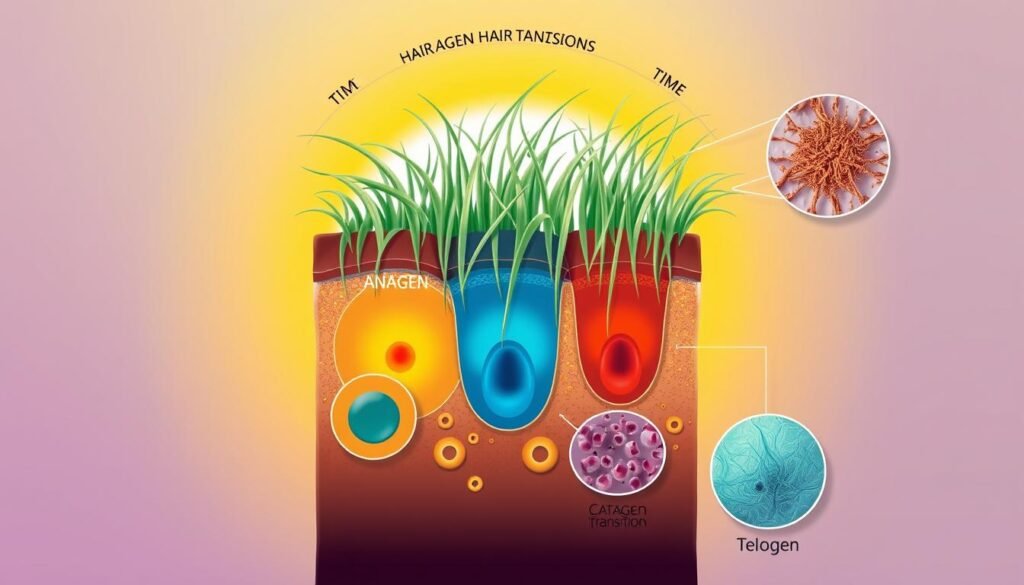
Common Myths About Hair Cutting
When it comes to hair care, there are several common misconceptions that persist. Let’s explore and debunk some of the most prevalent hair myths that are often believed to impact hair growth and health.
Myth 1: Cutting Hair Boosts Growth
One of the most widely believed hair myths is that cutting your hair regularly can stimulate faster growth. However, this is not entirely accurate. Hair growth occurs at the roots, not the ends, so trimming the ends does not directly influence the rate of growth. In fact, hair growth occurs at an average of a quarter-inch per month, regardless of whether you get haircuts or not.
Myth 2: Hair Types Affect Growth Rate
Another common misconception is that certain hair types, such as straight or curly, grow at different rates. While the texture and appearance of hair may vary based on its type, the actual growth rate is generally consistent across different hair types. Experts recommend getting a trim every 8-12 weeks to maintain the health of the hair while growing it, regardless of the hair type.
It’s important to separate these myths from the Facts when it comes to Hair Care and growth. Understanding the science behind hair cutting and growth can help you make more informed decisions about your hair routine and achieve your desired results.
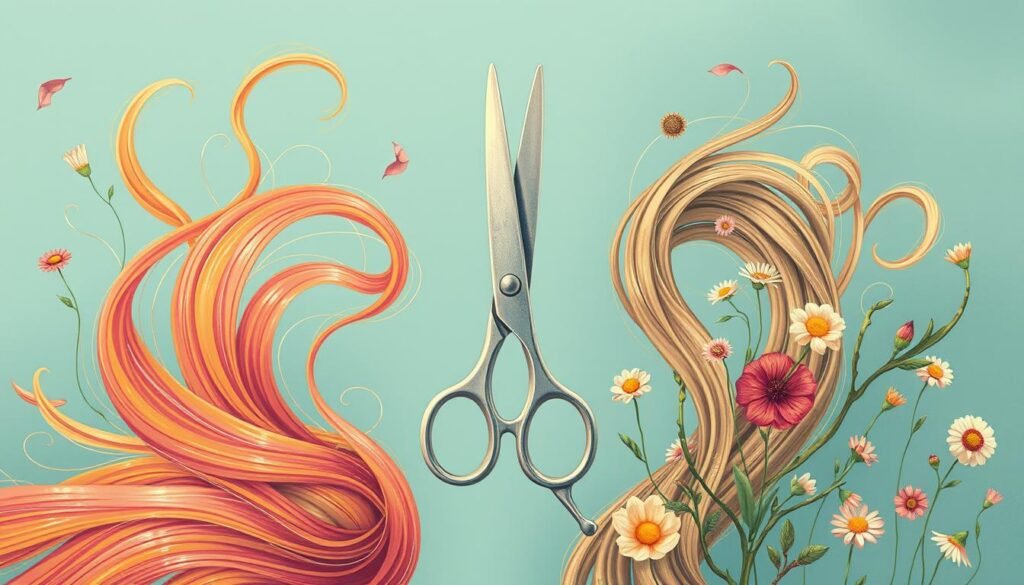
The Science Behind Hair Cutting
When it comes to the science behind hair cutting, the focus isn’t so much on accelerating growth rate, but rather on maintaining the overall health and integrity of the hair. While trimming may not directly impact the speed of hair growth, it plays a crucial role in preventing Damage and ensuring the hair remains strong and vibrant.
How Trimming Affects Hair Ends
Trimming the ends of the hair removes any split or damaged sections, preventing these issues from traveling up the hair shaft. Split ends can slowly split the hair strands, leading to breakage and slowing down the growth process. Regular trims help eliminate these problematic ends, keeping the hair healthy and strong.
The Role of Regular Haircuts
Even if haircuts don’t directly influence the rate of hair growth, regular trims are essential for maintaining the overall appearance and health of the hair. By removing damaged ends and promoting a more uniform shape, haircuts can enhance the hair’s vibrancy and manageability. This, in turn, supports the natural growth cycle and helps the hair reach its full potential.
The science behind hair cutting is less about boosting growth and more about preserving the integrity of the hair. Proper hair care, including regular trims, can create an environment that allows the hair to grow to its fullest and healthiest state.

“Trimming the ends of the hair is crucial for maintaining its overall health and appearance, even if it doesn’t directly impact the growth rate.”
Benefits of Regular Haircuts
Maintaining regular haircuts is essential for the health and appearance of your locks. Contrary to popular belief, trimming your hair does not make it grow faster. However, it can offer significant benefits that contribute to the overall health and vitality of your hair.
Reducing Split Ends
One of the primary advantages of getting regular haircuts is the prevention and reduction of split ends. As your hair grows, the ends naturally become more prone to splitting and breaking. Trimming off these damaged ends helps to keep your strands looking smooth, sleek, and healthy.
Enhancing Hair Health
Regular trims also play a crucial role in maintaining the overall health of your hair. When you get a haircut every 8 to 12 weeks, it allows your hair to stay in optimal condition throughout the growth process. This can result in stronger, more vibrant, and easier-to-manage hair, preventing further damage and breakage.
Experts recommend getting a trim every 6 to 10 weeks to maintain hair health, with those seeking longer lengths trimming every 8 to 12 weeks. The frequency may vary based on hair type, with fine or straight hair requiring more frequent trims and curly or coarse hair able to go longer between cuts.
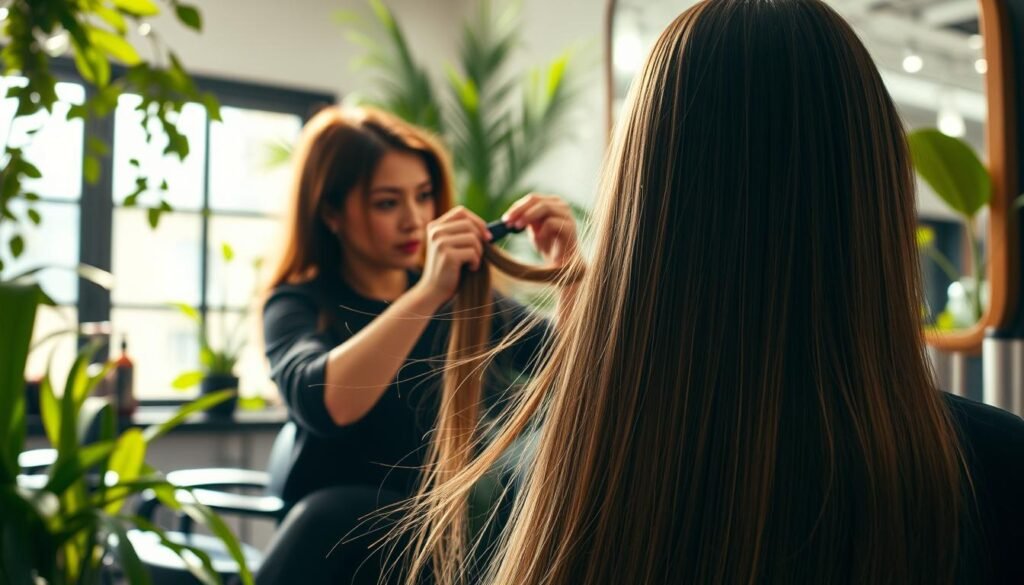
By incorporating regular haircuts into your hair care routine, you can enjoy the benefits of reduced split ends, enhanced shine, and improved overall hair health. Remember, a little trim can go a long way in keeping your hair health, hair treatment, and hair care in top shape.
Recommended Hair Care Practices
Maintaining healthy, vibrant hair requires a tailored approach to hair care. The key is to use high-quality, sulfate-free products that cater to your specific hair type and needs. Regular deep conditioning and scalp massages can also play a vital role in promoting blood flow to the hair follicles, which in turn supports healthy hair growth.
Moisturizing and Conditioning
Dry, brittle hair is more prone to breakage and split ends. Incorporating a weekly deep conditioning treatment can help restore moisture and elasticity to your locks. Look for nourishing ingredients like argan oil, shea butter, or coconut oil to deeply hydrate and condition your hair.
Using the Right Products
Avoid using harsh, drying products that can strip your hair of its natural oils. Opt for sulfate-free shampoos and conditioners that are gentle on your hair health. Additionally, consider using a leave-in conditioner or hair serum to provide extra hair care and protection, especially if you frequently use hot styling tools.
| Hair Care Product | Benefits |
|---|---|
| Sulfate-Free shampoo | Cleanses hair without stripping natural oils |
| Deep Conditioning Treatment | Replenishes moisture and strengthens hair |
| Leave-in Conditioner | Provides ongoing hydration and protection |
| Hair Serum | Smooths frizz and adds shine to hair treatment |
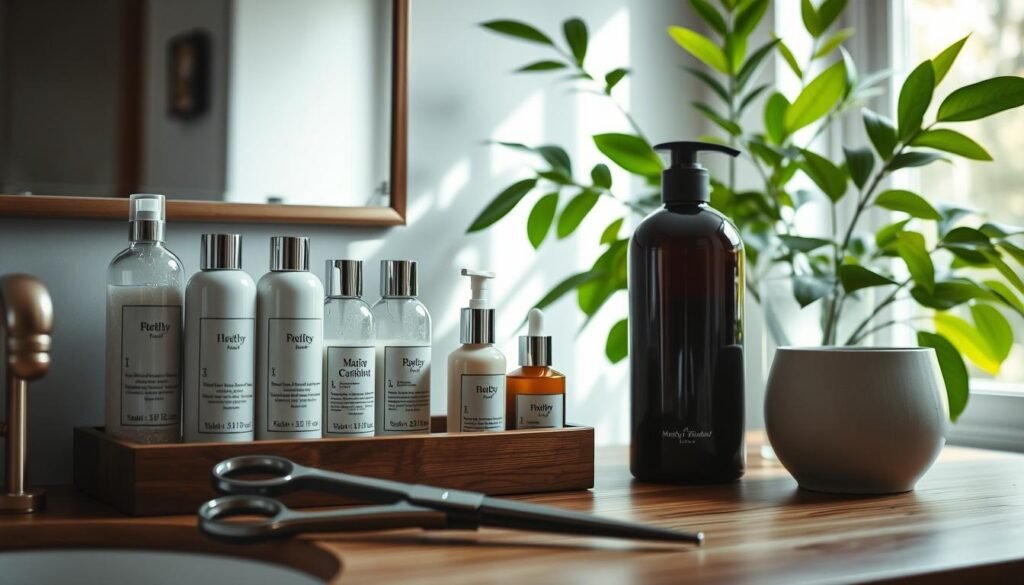
Remember, the key to maintaining healthy, vibrant hair care is to be mindful of the products you use and how you care for your hair. By following these recommended practices, you can promote hair health and enjoy beautiful, strong locks.
The Role of Diet in Hair Growth
Achieving optimal hair health and promoting faster growth requires a balanced, nutrient-rich diet. Certain foods have been shown to support various aspects of hair development, from nourishing the follicles to strengthening the strands.
Foods to Promote Healthy Hair
Incorporating the following hair-friendly foods can help boost hair health and hair growth:
- Eggs – Rich in protein and biotin, which are essential for hair growth. Hair follicles are primarily made of protein, and a lack of it can contribute to hair loss.
- Berries – Loaded with beneficial compounds and vitamins, such as vitamin C, which helps produce collagen to strengthen hair. Berries also contain antioxidants to protect hair follicles.
- Spinach – High in vitamins A and C, iron, and folate, all crucial for healthy hair growth. Iron helps carry oxygen for cellular metabolism and growth, and deficiencies can lead to hair loss.
- Fatty fish – Salmon and other fatty fish contain omega-3 fatty acids that may promote hair growth. They also provide protein, selenium, vitamin D3, and B vitamins for overall hair health.
Importance of Hydration
Proper hydration is just as crucial for hair health as a balanced diet. Drinking plenty of water helps keep the scalp hydrated, creating an optimal environment for hair growth. Dehydration can have a negative impact on the health and growth of hair.
By incorporating nutrient-rich foods and staying well-hydrated, you can support the overall health and growth of your hair.

When to Get a Trim
Deciding when to get a haircut can be a bit tricky, but understanding the signs that your tresses need a trim can help you keep your locks looking their best. From split ends to difficulty styling, there are several telltale signs that it’s time to visit your trusted stylist.
Signs Your Hair Needs a Cut
- Split ends: Those pesky split, frayed ends are a clear indication that your hair could use a little trimming.
- Increased tangles: If you find your hair is becoming increasingly difficult to manage and more prone to knots and tangles, it’s likely time for a trim.
- Lack of style: When your hair starts to lose its shape and becomes harder to style, a haircut can help restore its style and manageability.
Recommended Haircut Frequency
The ideal haircut frequency can vary depending on your hair type and length. As a general rule of thumb:
- Short styles: Every 3-4 weeks to maintain shape and prevent split ends.
- Textured hair: Every 2-3 months to keep hair healthy and manageable.
- Long hair: Up to 4 months between trims to retain length while addressing split ends.
Regular trims are essential for maintaining hair health and ensuring your style stays fresh and vibrant. By addressing split ends and providing a clean, even canvas, haircuts can promote stronger, more resilient tresses and support your overall hair care routine.

“Trimming your hair regularly is like pruning a plant – it encourages healthier, more vibrant growth.” – Celebrity Hairstylist, Jane Doe
Whether you’re trying to grow out your locks or simply maintain your current style, keeping a consistent trim schedule is key to achieving your hair goals. So don’t hesitate to make that salon appointment and let the experts help you keep your trimming hair, hair care, and hairstyles looking their absolute best.
Expert Opinions on Hair Cutting
When it comes to the age-old debate about whether cutting hair makes it grow faster, experts in the field of hair science and hair care have weighed in with their professional insights. Dermatologists and hair stylists offer valuable perspectives on the relationship between haircuts and hair growth.
Insights from Dermatologists
According to leading dermatologists, the health of the scalp is a critical factor in promoting healthy hair growth. “Maintaining a clean, well-moisturized scalp is key to encouraging new hair growth,” explains Dr. Sarah Johnson, a board-certified dermatologist. “Regularly trimming split ends can help prevent further damage and breakage, allowing hair to grow stronger and longer over time.”
Hair Stylist Tips
Experienced hair stylists echo the importance of regular trims for overall hair health and appearance. “While cutting your hair doesn’t make it grow faster, it’s essential for keeping your locks in top condition,” says master stylist Emma Thatcher. “Trimming away split ends every six to eight weeks can help prevent further damage, resulting in hair that looks and feels healthier.”
Experts in the field of hair treatment agree that while cutting hair doesn’t accelerate growth, it’s a crucial step in maintaining the optimal health and manageability of your tresses. By addressing split ends and promoting a healthy scalp environment, regular haircuts can contribute to the overall vitality and appearance of your hair.

“Regularly trimming split ends can help prevent further damage and breakage, allowing hair to grow stronger and longer over time.”
– Dr. Sarah Johnson, Dermatologist
Conclusion: Hair Cutting and Growth
While cutting your hair does not directly increase the rate of hair growth, regular trims are essential for maintaining healthy, strong, and vibrant locks. The key to achieving optimal hair health lies in a holistic approach that encompasses proper hair care, nutrition, and consistent maintenance.
Summarizing Key Takeaways
Throughout this article, we’ve explored the myths and Facts surrounding hair cutting and its impact on growth. We’ve learned that while trimming the ends of your hair won’t accelerate its overall growth rate, it can help prevent split ends, reduce breakage, and enhance the overall appearance and texture of your hair. Regular haircuts, along with a balanced diet rich in hair-nourishing nutrients, can work together to promote healthy, luscious hair.
Final Thoughts on Hair Care
The secret to achieving long, healthy hair lies in focusing on overall hair health rather than relying on myths or quick fixes. By incorporating a regular trimming routine, maintaining a nutrient-rich diet, and implementing gentle hair care practices, you can create an environment that supports optimal hair growth and vitality. Remember, hair care is a journey, and with patience and the right approach, you can enjoy the rewards of strong, vibrant, and beautiful locks.
FAQ
Does cutting hair make it grow faster?
No, cutting hair does not directly make it grow faster. Hair growth starts at the scalp, and the rate of growth is typically about 0.35 millimeters per day, or around 6 inches per year, regardless of how often you trim the ends.
How does trimming hair affect hair growth?
While trimming hair doesn’t accelerate growth, it can contribute to healthier hair by preventing split ends from traveling up the hair shaft. This can make hair appear thicker and more luscious.
Do different hair types affect hair growth rate?
No, hair growth rate is generally consistent across different hair types. Factors like scalp health, nutrition, and overall hair care practices have a greater impact on hair growth than the specific hair type.
How often should I get a haircut?
The recommended trim frequency varies based on hair length and texture. Generally, it’s advised to get a trim every 3-4 weeks for short styles, 2-3 months for textured hair, and up to 4 months for longer hair to maintain health and appearance.
What are the benefits of regular haircuts?
Regular haircuts help remove damaged ends, prevent split ends from traveling up the hair shaft, and maintain the overall health and appearance of your hair. This can lead to smoother, healthier-looking hair and reduced breakage.
What can I do to promote healthy hair growth?
In addition to regular trims, maintaining a balanced diet rich in vitamins and minerals, using quality, sulfate-free hair products, and practicing good hair care habits like deep conditioning and scalp massages can all contribute to healthy hair growth.
